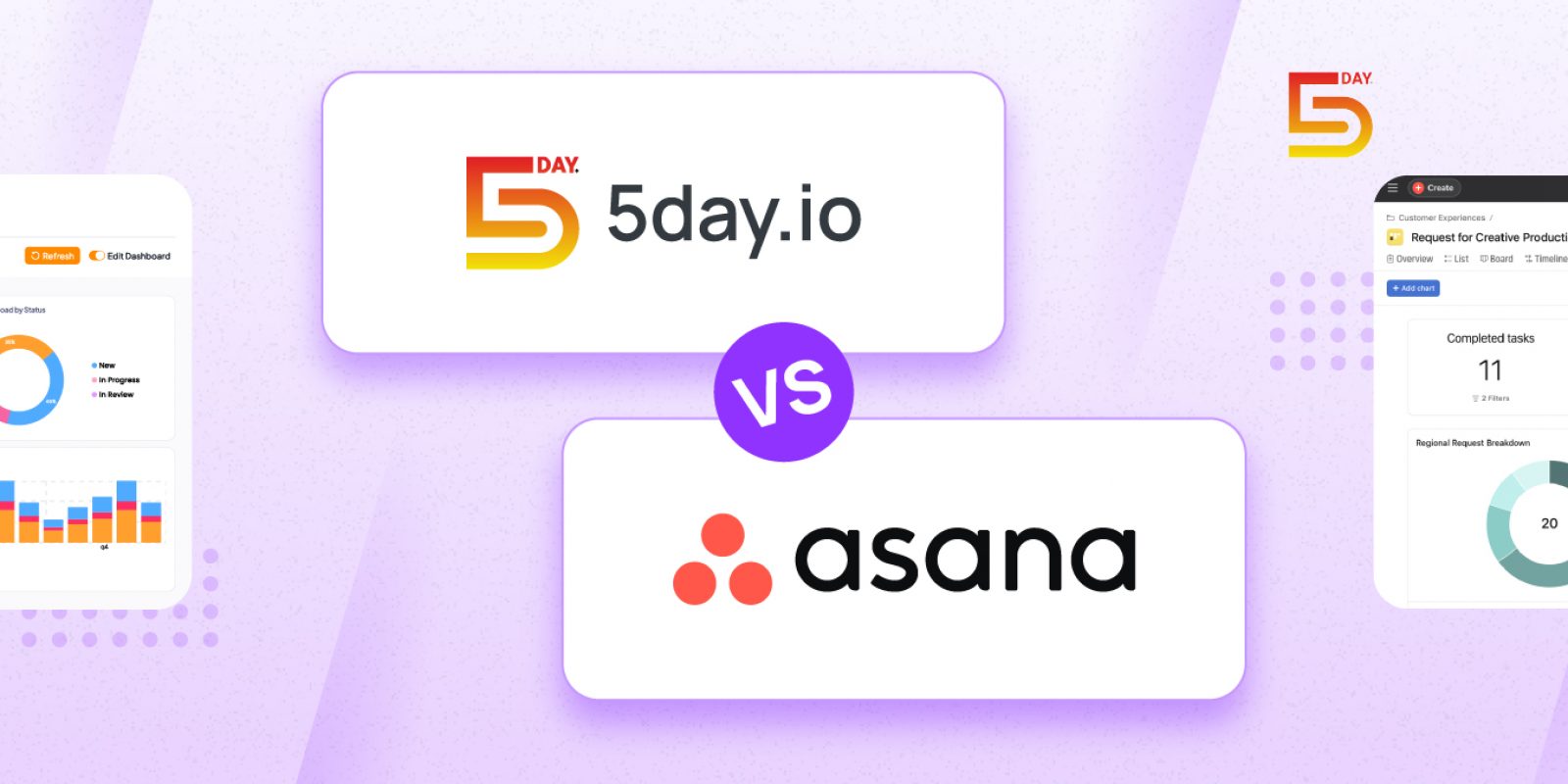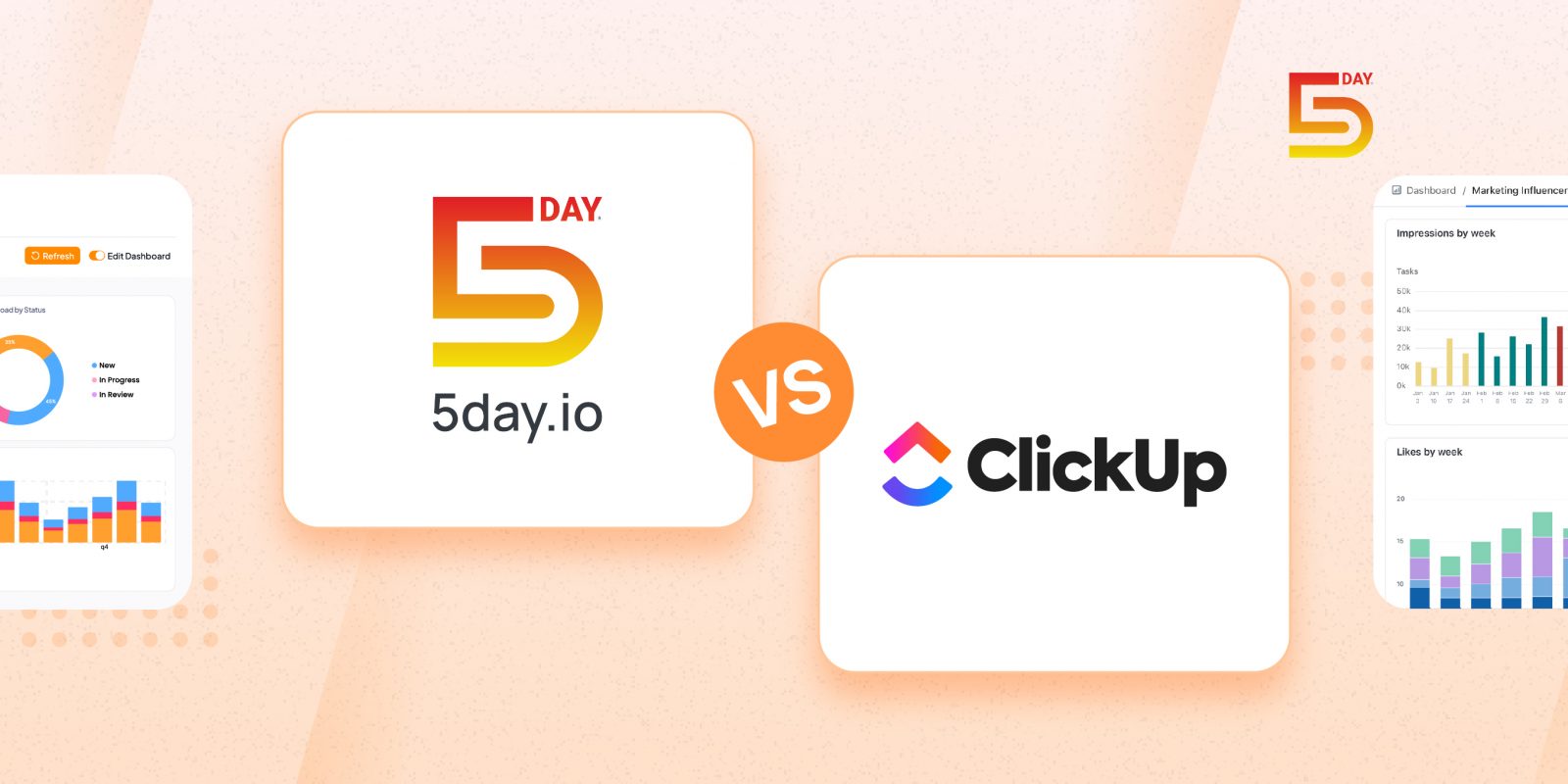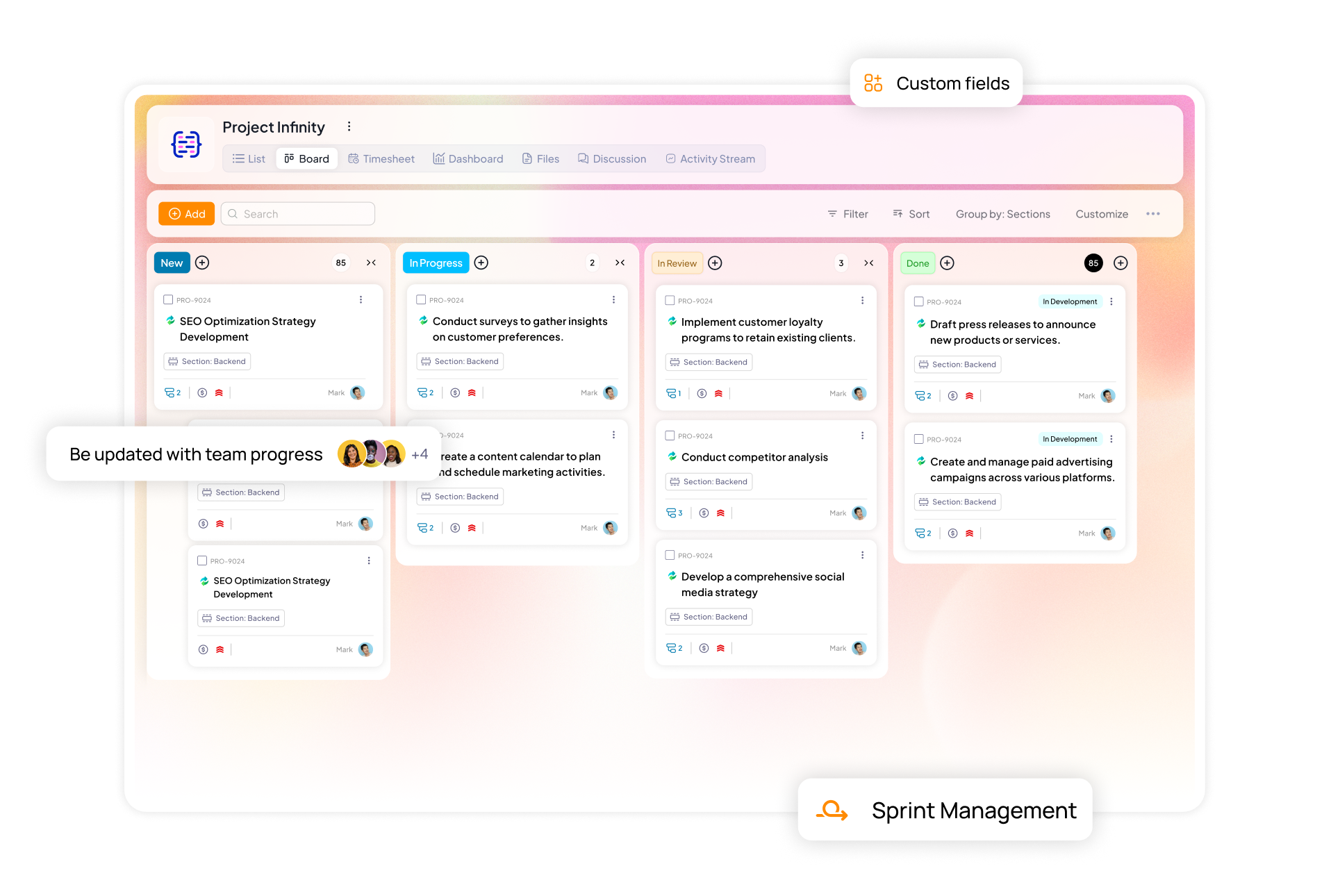Marketers are experts at reading numbers. They use conversions and ROI to shape everyday decisions. But when it comes to their own timelines, many teams find it tricky to plan with the same precision.
The truth is that most teams already have the insights they need to plan better. It’s just a matter of putting that information to use. With thoughtful time estimation for marketing, you can use past performance and structured methods to create forecasts you can count on.
It results in smoother workflows and the confidence to deliver on time. In this article, you’ll learn why time estimation matters and practical techniques to make your estimates more reliable.
Importance of accurate time estimates for marketers
Accurate time estimation in project management is much needed for marketing success. It helps teams set realistic deadlines and keep stakeholders on the same page. For example, Wellington research shows that only 29% of organizations complete projects on time. The primary reason for this is poor time estimation.
When marketers underestimate campaign tasks, launches run late, and clients feel frustrated. Accurate estimates help teams allocate resources efficiently and set clear expectations. By tracking hours and comparing them to estimates, managers quickly spot bottlenecks and address them before they escalate.
Benefits of accurate time estimates include:
On-time delivery
Realistic timelines ensure campaigns hit their deadlines. Projects planned with solid estimates are far more likely to launch on schedule.
Budget control
Knowing how long each task takes prevents cost overruns. If a team consistently estimates well, budgets stay intact, and ROI is easier to track.
Team trust
Reliable schedules build confidence. When you consistently hit estimates, clients and managers learn they can trust your planning. Good time planning sets realistic project expectations and helps avoid scope creep.
Performance insights
Comparing estimated vs. actual hours provides data to refine future plans. Tracking real hours per task helps improve your next round of estimates.
Common challenges in estimating marketing tasks
Estimating time for tasks in marketing comes with unique hurdles. Marketers handle creative, varied work, which makes predictions hard. These challenges include:
Creative uncertainty
Marketing tasks often involve creativity and iteration. Unlike routine work, creative tasks don’t have fixed formulas. Teams may underplay the time needed for ideation and revisions.
Scope creep
Campaign requirements can change on the fly. A project that started as 4 blog post work might grow into creating graphics, videos, captions, or extra revisions. Without strong controls, additional requests push timelines out.
Approval delays
Unlike software tasks, marketing work often needs client or management sign-off at each step. Waiting for feedback on a logo or ad concept can add days, but teams sometimes forget to account for those delays.
Task dependencies
Marketing often involves collaboration across teams. If one team’s work, like video editing, depends on another team, say script approval, a holdup in one phase delays everything.
Optimism bias
Marketers, like all people, tend to be optimistic. It’s easy to assume a task may take about an hour, only to find it’s more complex. Marketing agencies often find that underestimating unique tasks is a top cause of missed deadlines.
Limited historical data
Without past data on similar campaigns, teams often guess blindly. A new product launch or untested channel has no precedent, making it harder to base estimates on history.
Together, these factors mean that marketing estimates can easily go awry if not handled carefully. For instance, neglecting to factor in the client revision rounds could turn a 2-day task into 4 days. The key is to recognize these pitfalls and build in buffers and checks.
Using techniques like work breakdown of tasks and data-driven methods helps overcome these challenges.
Factors to consider when estimating marketing tasks
Strong estimates start with awareness. The more you understand what shapes a task’s duration, the more realistic and actionable your project plan becomes.
To make your estimates more grounded, consider these factors for every task or campaign.
Task complexity and type
Understand the complexity of the task. If a task is a quick copywriting job or a full brand campaign. Complex tasks, like video production, naturally need more time than simpler ones.
Team experience
An experienced designer or writer will likely complete a task faster than a new hire. Always factor in who will do the work. This also helps manage resources in a better way and estimate time for marketing tasks accurately.
Resource availability
Before assigning any task, find out if the right people are free or if they are juggling other projects. If a key team member is on vacation or swamped with other work, it’s better to extend your timeline.
After all, every estimate is ultimately a trade-off between time, cost, and scope, the three constraints of the project management triangle. For marketers, acknowledging these constraints sets campaigns up for realistic timelines and healthier outcomes.
Task dependencies
Map out any tasks that depend on others. For example, designing a brochure may depend on client feedback or a copywriter’s draft. Tasks with many dependencies should have extra caution in estimates.
Client approvals and meetings
Count the rounds of review required for each task. Each round of feedback from a manager or client can add days. If a campaign needs stakeholder signoffs, add time for those meetings.
Historical data
Use past projects as a guide. If you’ve launched similar campaigns, check how long each part took. Analyzing historical data lets teams provide more accurate estimates and avoid overpromising.
Work breakdown
Break projects into subtasks. The more granular your breakdown, the more accurate your sum. PMI advises that you should identify the amount of work, develop a detailed work breakdown structure, and create a list of tasks to get good estimates.
Risk and buffer time
Always include a time buffer for the unknowns (often 10–20%). If a task might have hidden complications, pad your estimate. It helps avoid project overruns and saves from wrong estimations due to unforeseen circumstances.
Time tracking formats
Decide how your team logs time. Whether it’s hours, days, or story points, make sure the team uses a consistent format so that time logs remain comparable.
For example, if you’re estimating a social media campaign, you might list subtasks like design graphics, write captions, schedule posts, and report results. Estimate each based on who does it and past experience.
Also consider that content approvals and edits might require extra reviews. By thinking through each factor, like scope, team, resources, and past data, your estimates will reflect the project’s real complexity.
Proven time estimation techniques for marketing teams
No single method fits every scenario. That’s why savvy teams often use a mix of techniques. Here are some proven approaches that marketing teams can apply for better time estimation in project management.
Bottom-up estimation
Break the project into individual tasks (and subtasks) and estimate each one separately, then sum them up. This helps estimate accurate results because you’re considering every detail.
For example, when planning a product launch, estimate content creation, design, ad setup, etc., each on its own.
Pro tip: Bottom-up works best when you have clear tasks and can rely on team input for each piece.
Historical/analogous estimation
Use data from similar past campaigns. If last quarter’s email campaign took 10 hours total, a similar one now might too. This is quick but assumes the new task closely matches the old one.
Say, for instance, if you’ve launched 5 comparable product ads before, use their average completion time as a guide. Parametric estimating (a subtype) multiplies units by standard rates like 0.5 hours per blog page.
Analogous methods are handy in early planning or when details are sparse.
PERT (Three-point estimation)
Another useful technique is Program Evaluation and Review Technique (PERT) or three-point estimation. For tasks with uncertainty, use three numbers:
- An Optimistic (O) estimate
- Pessimistic (P) estimate
- Realistic (R) estimate
Then, calculate a weighted average, using the following formula:
(O + 4R + P) / 6
This gives more weight to the realistic case but accounts for the best/worst scenarios.
Let’s take an example,
If graphic design is 2 days best-case, 3 days most likely, and 5 days worst-case, the PERT estimate is (2 + 4×3 + 5)/6 ≈ 3.
Planning poker (Agile consensus)
Originating in software teams, planning poker can work for marketing projects too. The team gathers, discusses a task, then each member secretly chooses an estimate (often using cards) and reveals it simultaneously.
If there’s disagreement, the team discusses reasons and votes again. This gamified approach gathers the team’s collective insight and often produces more accurate estimates than a single person’s guess.
Planning poker makes estimations more engaging and accurate because they’re based on group consensus. It’s especially useful for agencies using agile or sprint methods.
Expert judgment
Sometimes the fastest way is to ask an experienced team member or a consultant. For example, a senior designer might have a good sense of how long a branding project will take.
Expert judgment is best when projects are new or there’s little data. But, sometimes, it’s subjective, so consider combining it with other methods (or maybe have 2 experts give independent estimates).
Parametric estimation
This uses predefined metrics. For example, if on average a writer produces 500 words per hour, a 2000-word article might be estimated at 4 hours.
This works well for repetitive, measurable tasks. Make sure the unit rates come from data or prior runs, instead of just guesswork.
Below is a quick comparison of all the above-cited techniques:
Technique | How it works | Best used when |
Analogous | Based on past similar projects, like the last ad campaign or parametric rates (units×rate) | You have related historical data; a quick, early estimate needed |
Parametric | Multiply the known time-per-unit by the quantity For example, minutes per page × pages | Tasks are repetitive and easily quantifiable |
Bottom-up | Break the project into subtasks, estimate each in detail, and then add up | You have a clear task list and can afford detailed planning |
Three‑point (PERT) | Use an optimistic, pessimistic, and likely estimate Calculated as O+4R+P / 6 | Tasks are uncertain or high-risk; want to factor in variability |
Planning poker | Team members give relative estimates (using cards or points) and reach consensus | Working in sprints or Agile, engaging the whole team to refine estimates |
Expert judgment | An experienced person gives an estimate based on knowledge or research | New, unique projects lacking data; a quick sanity check needed |
Each method has strengths. For example, bottom-up is thorough but time-consuming, while analogous is fast but less precise.
A common practice is to use an initial analogous/parametric estimate and then refine it via bottom-up or team discussion. Combining approaches yields the best accuracy for project time estimation.
How to use project management software for better estimation
Modern project management software for marketers can greatly improve the estimation process. Here’s how to use them for more accurate time estimation for marketing:
Dashboards and real-time metrics
Project management software offers dashboards that collect live data as work progresses. A good dashboard shows estimated vs. actual time for each campaign.
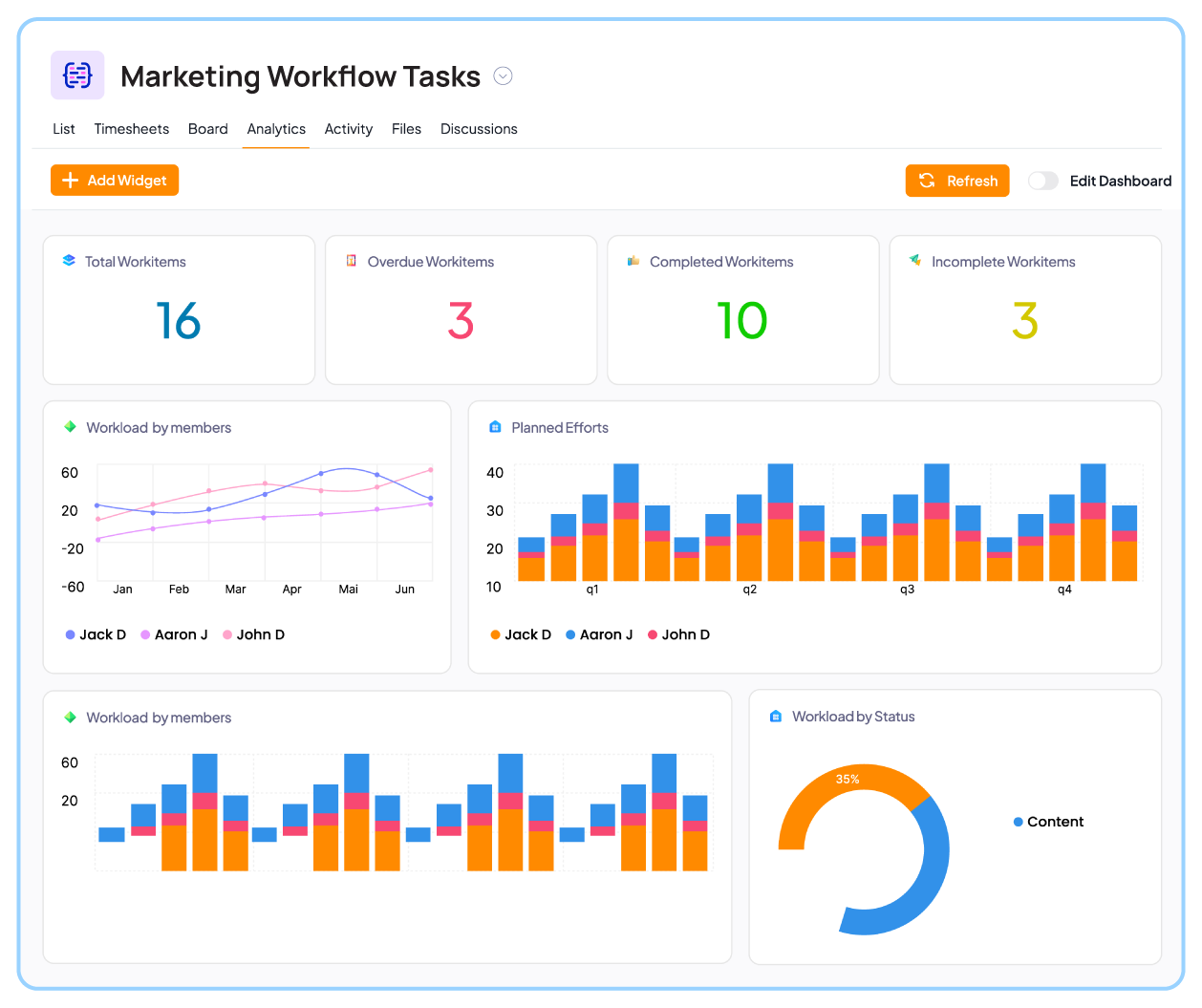
In practice, you could have a widget that shows total hours logged each week vs the plan, making it easy to adjust estimates.
Historical time logs
Using software with time-tracking lets you build a library of actual hours spent. If every designer logs hours on tasks, the next time you plan a similar campaign, you can pull those hours as a baseline.
This way, your analogous estimates are grounded in real data. Many teams generate reports from past projects to inform new plans.
Templates and standardization
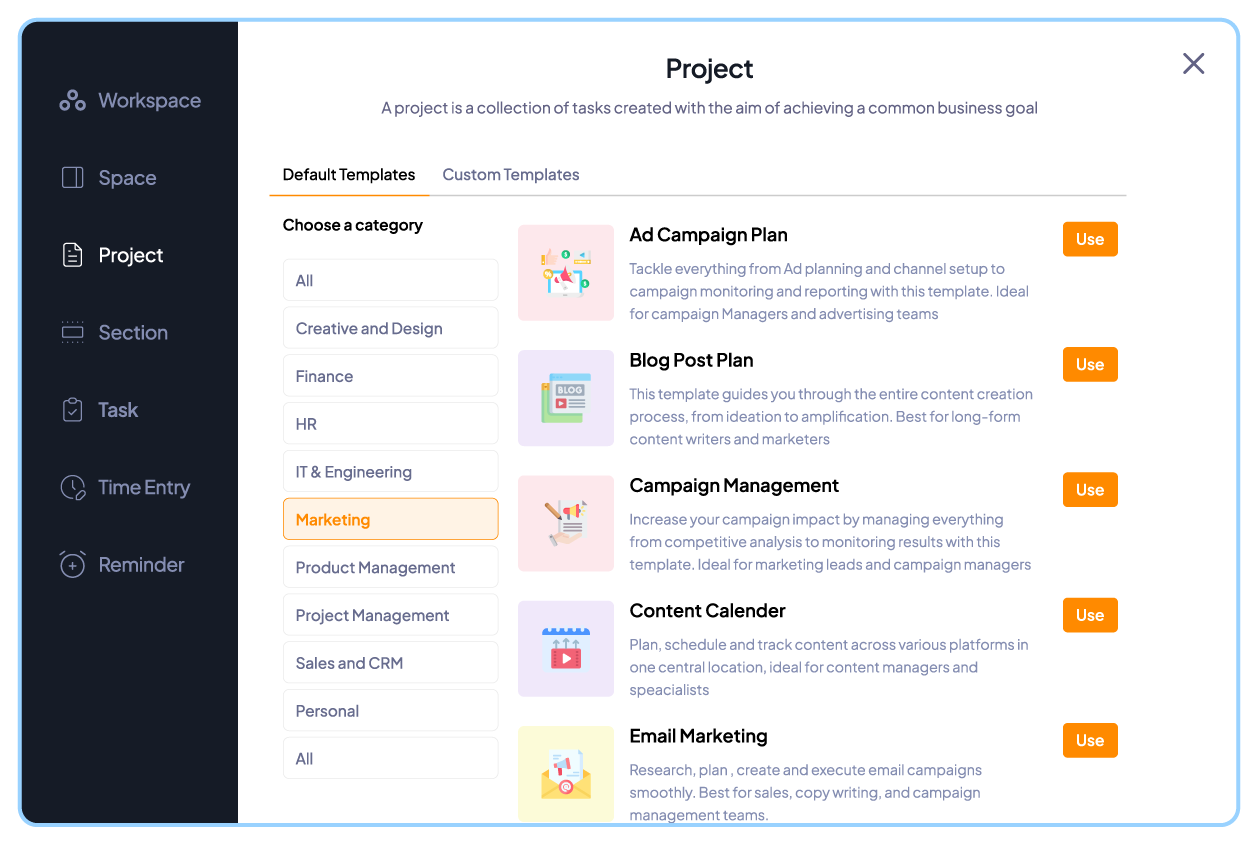
Marketing often involves recurring workflows. Instead of starting time estimates from scratch for every task, use project templates.
Many project management software (including 5day.io) offer templates designed for marketing workflows. A template pre-populates tasks like draft, review, and publish, with default estimates. This ensures consistency and saves setup time for common project types.
Task dependencies
Visualizing task order is crucial for timing. You can see dependencies and adjust timelines if one task slips.
5day.io’s marketing features explicitly include multiple project views for mapping tasks. It allows you to immediately see the impact of all changes. If a design takes 2 days instead of 1, you can shift linked tasks in the schedule and manage further dependencies.
Estimation formats and timesheets
A project management software built specifically for marketing teams lets you enter estimates in various formats (hours: minutes, days & hours, story points etc.).
Pick the format that fits your style. Then, team members use timesheets to record actual time. Crucially, you can require timesheet approvals so that logged hours are reviewed and confirmed. This keeps data clean and ensures everyone updates their hours.
Using the built-in timesheet instead of a spreadsheet also automatically ties time to tasks and projects, making summary reports straightforward.
Templates for estimation
Some tools allow saving estimation baselines. For example, once a project plan is approved, you can save its schedule as a baseline.
Later, you can compare actual progress to that baseline, highlighting where tasks took more or less time. This helps refine future estimates.
Using such features turns estimation from guesswork into an ongoing process. Every time your team updates hours or moves tasks, the dashboards and reports refresh. Over time, this creates a feedback loop: your initial estimates feed real data into the system, which in turn informs more accurate future estimates.
How 5day.io supports accurate time estimation for marketing teams
![]()
Estimating time for tasks accurately is a learned skill. By accounting for all factors (task size, team skills, complexity, dependencies) and using structured methods (breakdowns, PERT, consensus), marketing teams can make far more reliable plans.
Project management software for marketers like 5day.io is the glue that holds it together. It tracks what actually happens and surfaces where your guesses were off. It offers marketing-specific planning views, timesheet approvals, and custom dashboards so you always know how your estimates compare to reality.
Here’s how:
- 5day.io supports multiple input formats for estimates, like hh: mm, days & hours like ‘1d 3h 30m’, or decimal hours
- Timesheet approvals and reminders for every user to log time on tasks via timesheets
- It allows you to create tasks, subtasks, and even sub-subtasks (multi-level sections)
- Timesheet tracking (daily and weekly views) for users and managers to see time logs in a calendar or list format
- Board views for scheduling tasks through stages like To Do → In Progress → Done
- It offers an interface to support multiple assignees and statuses
- Project dashboards give real-time insights into time spent and remaining for every project, team, or person
In short, 5day.io turns the time estimation process into a data-driven workflow. Teams have the project management tools to break down tasks, log time, approve hours, and monitor everything on dashboards. Over time, this leads to smarter future time estimates, fewer surprises, and more predictable campaigns.
Ready to make your campaign delivery time more accurate? Try 5day.io free for 30 days (no credit card needed) and see how built-in time estimation tools and analytics widgets can simply work for you.
Frequently Asked Questions
How to improve estimate accuracy for new or unique tasks?
Use data and break tasks down. When facing something new, start by subdividing it into smaller pieces. For each subtask, use analogies to past work or ask experts.
For example, if writing a press release for the first time, break it into:
- Draft outline
- Write content
- Internal review
And, estimate the time for each task. Use any available data for the first press release. If your content writer usually writes 500 words in 2 hours, use that rate for the draft.
Also, track the actual time spent. The next time you do a similar release, you’ll have a historical baseline. Over time, this feedback loop (estimate → actual → adjust) makes your guesses much better.
Should we estimate marketing work in hours or story points?
Both can work, but consistency is key. If you bill by the hour or clients expect hourly budgets, estimating in hours (or days) is straightforward.
Teams using agile methods sometimes use story points, which are abstract units that reflect effort. In 5day.io, you can choose your estimation format (hours vs points) and still log time. The important thing is to pick one approach and use it uniformly.
If you use points, track how many hours correspond to 1 point on average, so you can always convert when planning or reporting.
How much contingency should we add to estimates?
It varies by task risk. A common rule is to add 10–20% of the total estimate as contingency. For example, if a campaign is estimated at 50 hours of work, plan for 55–60 hours.
Higher risk tasks (like a technology-dependent deliverable) might need more buffer. The three-point (PERT) method inherently includes a buffer by factoring pessimistic scenarios.
Also, make sure to explicitly note the buffer in your plan, so stakeholders are aware of it.



